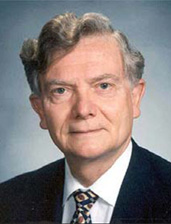Lehigh University
Office or Center Name Here
John W. Fisher
Professor Emeritus of Civil Engineering
Director Emeritus, ATLSS Engineering Research Center
Lehigh University, Bethlehem, PA
Overcoming Barriers to Durable Steel Bridge Systems click here to view video
Friday, April 18th, 2008
4:10 P.M.
Sinclair Laboratory Auditorium
Overview:
Experience with steel bridges has demonstrated that one of the primary barriers to durability was inadequacies in the fatigue design criteria and practice prior to 1974. The development of a rational fatigue resistance knowledge base and the introduction of stress range as the appropriate fatigue design criteria minimized this limitation. [...] More recent work on Ultrasonic Impact Treatment (UIT) together with the need for end weld design changes are shown to effectively eliminate fatigue as controlling design.
For the future, High Performance Steels (HPS) are providing enhanced weathering resistance for uncoated members along with more reliable fracture resistance and weldability. Control of water and debris by minimizing joints in bridge decks offers enhanced protection for both coated and uncoated bridge members. The orthotropic steel deck is shown to be a system providing modularity for prefabrication and easy erection. This system is capable of providing a 100 year life when thicker deck plates are used with thin epoxy concrete wearing surfaces. These have been shown to permit immediate use and are not pot hole sensitive even if local surface deterioration develops.
DR. JOHN W. FISHER: John W. Fisher was Professor of Civil Engineering at Lehigh University since 1969, and became Professor Emeritus in 2002. He was Director of the Engineering Research Center on Advanced Technology for Large Structural Systems (ATLSS) since its establishment by NSF in May 1986 until September 1999. Dr. Fisher is a graduate of Washington University, St. Louis, Missouri, with M.S.CE and Ph.D. degrees from Lehigh University.
A structural engineer, Dr. Fisher is a specialist in structural connections, the fatigue and fracture of riveted, bolted, and welded structures, the behavior and design of composite steel-concrete members, and the performance of steel bridges. In 1986 he was elected a member of the National Academy of Engineering. In 1989 he was elected an Honorary Member of the American Society of Civil Engineers. He was the first academic to receive the Construction-Man-of-the-Year Award from ENR in 1987 and was named one of the 125 engineers identified by ENR editors for outstanding contributions to the construction industry since 1874 in 1999. In 1992 he was awarded the Frank B. Brown medal by the Franklin Institute for his contributions to structural engineering. In 1995 he was awarded the John A. Roebling Medal for lifetime Achievement in Bridge Engineering. In 1997 he was named the Distinguished Lecturer by the Transportation Research Board and the Portevin Lecturer by the International Institute of Welding. In 2000 he was awarded the John Fritz Medal for researching safety and performance of steel structures for the public good, and the Transportation Research Board Roy W. Crum Distinguished Service Award for his contributions to bridge engineering and research. In 2001 the International Association of Bridge and Structural Engineering elected him the Laureate of the International Award of Merit in Structural Engineering. In 2002 the International Association of Bridge Maintenance and Safety awarded him for Bridge Safety. In 2006 he received the Geerhard Haaijer Award for Excellence in Education from the American Institute of Steel Construction. And in 2007 he was awarded the Outstanding Projects and Leaders (OPAL) Lifetime Achievement Award in Education by the American Society of Civil Engineers. Dr. Fisher has published over 275 articles, reports and books in scientific and engineering journals.
Overcoming Barriers to Durable Steel Bridge Systems:
Experience with steel bridges has demonstrated that one of the primary barriers to durability was inadequacies in the fatigue design criteria and practice prior to 1974. The development of a rational fatigue resistance knowledge base and the introduction of stress range as the appropriate fatigue design criteria minimized this limitation. Small web gaps and arbitrary rules to avoid welding to tension flanges resulted in extensive web gap fatigue cracking from out-of-plane distortion. Small web gaps can also result in tri-axiality resulting in brittle fracture. Improvements of existing details by end weld treatment using peening and gas tungsten arc remelting are examined as procedures to enhance the fatigue resistance of existing structures. Experience with these procedures since the 1970's is reviewed. More recent work on Ultrasonic Impact Treatment (UIT) together with the need for end weld design changes are shown to effectively eliminate fatigue as controlling design. For the future, High Performance Steels (HPS) are providing enhanced weathering resistance for uncoated members along with more reliable fracture resistance and weldability. Control of water and debris by minimizing joints in bridge decks offers enhanced protection for both coated and uncoated bridge members. The orthotropic steel deck is shown to be a system providing modularity for prefabrication and easy erection. This system is capable of providing a 100 year life when thicker deck plates are used with thin epoxy concrete wearing surfaces. These have been shown to permit immediate use and are not pot hole sensitive even if local surface deterioration develops.
The Fazlur R. Khan Distinguished Lecture Series has been initiated and organized by Dan M. Frangopol, the first holder of Lehigh's Fazlur Rahman Khan Endowed Chair of Structural Engineering and Architecture.
